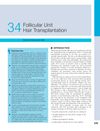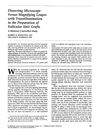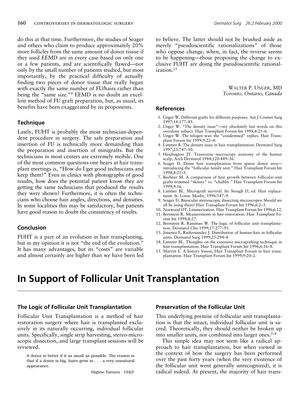TLDR The document concludes that Follicular Unit Hair Transplantation is a more precise and effective method for hair restoration.
The document critiques the Extended Elliptical Donor method for hair transplantation due to its reliance on small sample sizes and challenges in comparing donor tissue, while advocating for Follicular Unit Hair Transplantation (FUHT). It points out the technical skill required for FUHT and the importance of maintaining follicular unit integrity to ensure better aesthetic outcomes and hair growth. The document also notes the advantages of FUHT, such as smaller wounds and the efficient use of donor hair, and the role of microscopic dissection in reducing damage to follicles. It concludes that although FUHT is not universally adopted, its principles have greatly influenced hair restoration surgery towards more scientific and precise techniques.
172 citations
,
December 1994 in “The Journal of Dermatologic Surgery and Oncology” This hair transplant method improves cosmetic results for hair loss.
 4 citations
,
January 2005 in “Elsevier eBooks”
4 citations
,
January 2005 in “Elsevier eBooks” Follicular Unit Transplantation is a precise hair restoration technique that requires careful planning and a skilled team, and Follicular Unit Extraction offers a less invasive option.
 5 citations
,
February 2019 in “Oral and Maxillofacial Surgery”
5 citations
,
February 2019 in “Oral and Maxillofacial Surgery” Hair loss can be reversed or even cured using advanced hair restoration techniques, with rare complications like swelling and bleeding.
 25 citations
,
August 1998 in “Dermatologic Surgery”
25 citations
,
August 1998 in “Dermatologic Surgery” Dissecting microscopes give more and better quality hair grafts than magnifying loupes.
 32 citations
,
July 2011 in “Facial Plastic Surgery”
32 citations
,
July 2011 in “Facial Plastic Surgery” New hair transplant methods offer more natural results and better graft survival, with ongoing research to increase donor hair options.
 3 citations
,
August 2011 in “InTech eBooks”
3 citations
,
August 2011 in “InTech eBooks” The document concludes that skin grafts are essential for repairing tissue loss, with various types available and ongoing research into substitutes to improve outcomes and reduce donor site issues.





